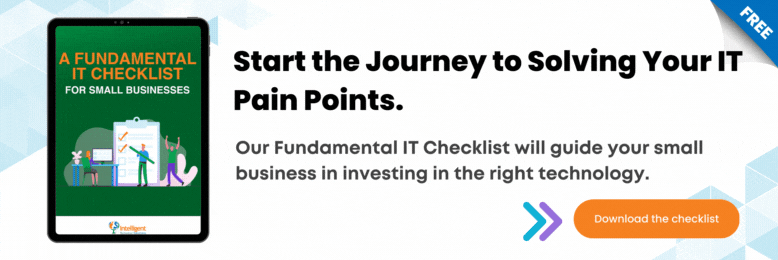What Computer Should I Buy? (A 5 Step Guide)
December 3rd, 2021 | 4 min. read

Imagine a time you bought something you wanted but eventually put it aside and left to gather dust. What a waste, right? Now imagine this happening in your business - a place where you don’t have the resources to waste.
You don’t want to choose the wrong kinds of workstations for your business.
But unfortunately, the question “What computer should I buy?” does not have a straightforward answer. Each user has a different need, and therefore a different kind of computer is needed for each user.

Here at Intelligent Technical Solutions, we’ve walked clients through our equipment options for their workstations. We use these steps to help clients choose which kind of computer is the best for them.
Step #1: Decide what you’ll use the computer for
Step #2: Point out what qualities you’ll prioritize
Step #3: Commit to either buying a complete computer or building your own
Step #4: Research. Research. Research.
Step #5: Decide where you’re going to buy the PC
Going over each of these steps will help guide you through purchasing your workstations. By the end of this article, you’ll have a solid foundation of knowledge before buying a PC.
Step #1: Decide what you’ll use the computer for.
The first step before buying a computer is to decide what you’ll use it for. Usually, we recommend that you work with what you have unless you’ve reached the signs to upgrade your IT equipment.
If your needs are beyond the capabilities of the equipment you have, you need to answer some questions to figure out the purpose of your computer. Some questions for that are:
- What applications will you use?
- How much memory do you need?
- How intensive will you use the computer?
- How much flexibility for expansion do you need?
- Do you have specific requirements that your computer needs to meet?
Be careful not to underestimate or overestimate the needs of your business as well! If you underestimate the specs, your programs won’t work. If you overestimate your specs, you’ve ended up wasting money.
(Like buying a gaming rig when you’re a writer and barely play video games. Did I do this? Maybe.)
After being clear with what you’re going to use your computer for, proceed to Step #2.
Step #2: Point out what qualities you’ll prioritize
When choosing a computer, you need to consider what qualities you’ll prioritize. The following attributes are different from the uses you’ll get out of the computer since these now deal with the quality of the equipment, not the function.
Price
![]() Price is probably the first thing that pops into your mind when thinking about what you need to buy. It’s the ride-or-die quality that dictates everything you can buy.
Price is probably the first thing that pops into your mind when thinking about what you need to buy. It’s the ride-or-die quality that dictates everything you can buy.
Decide your budget and do your best to stick to it. But remember, price isn’t everything! Before saying you won’t budge on what you’re willing to spend, review the other qualities.
Longevity
 Decide how long you want the item to last for you. A year? Two years? Until it breaks? Until it’s outdated? Does it matter to you that it stays functional until you’re sick of it, or are you someone who wants to constantly replace equipment and swap it out with the latest versions?
Decide how long you want the item to last for you. A year? Two years? Until it breaks? Until it’s outdated? Does it matter to you that it stays functional until you’re sick of it, or are you someone who wants to constantly replace equipment and swap it out with the latest versions?
The more durable an item, the less you must spend on repairs and replacements in the long run. Decide if you’re more comfortable spending a bit more to get something that will last longer or if the cost of replacing tools and getting something that’s newer is worth it to you.
User Experience

User Experience means valuing the ease of use for the end-user. By prioritizing this, you’re saying your team member’s or customers’ comfort comes first, so you need a solid grasp on who will use the equipment.
Customer Support Services
![]() Do you want other people to manage your devices with utmost efficiency (which will cost you money), or do you want to put the burden of keeping everything up and running yourself (which will cost you time and effort)?
Do you want other people to manage your devices with utmost efficiency (which will cost you money), or do you want to put the burden of keeping everything up and running yourself (which will cost you time and effort)?
By deciding how vital customer support is for you, you can research which businesses provide reliable customer support for their products. If you don’t value this quality, you can cross out an extra research step in your buying process.
Rank them!
.png?width=100&name=Rank%20them%20(2).png) After going through these qualities, rank them. Which comes first and last? Take note that you should not put two characteristics on the same level because this will complicate your decision-making process. You’ll have to grapple with more options, but the next steps should come easily if your values are clear.
After going through these qualities, rank them. Which comes first and last? Take note that you should not put two characteristics on the same level because this will complicate your decision-making process. You’ll have to grapple with more options, but the next steps should come easily if your values are clear.
Step #3: Commit to buying a pre-assembled computer or building your own computer
Deciding if you want to buy a pre-assembled unit or build your own computer will drastically lessen the amount of time you need to spend researching.
You can also pinpoint what kinds of brands you will look into, as each company specializes in different equipment.
Step #4: Research. Research. Research.
This takes the longest. You need to read reviews of products and understand the function of the equipment.
While researching, take note of the qualities that matter to you and filter your choices based on these qualities. What are the cheapest brands? Which brands have the best user experience or have a reputation for durability?
Make a list of all the products you’re considering and narrow down your choices to three. Rank those three from best to worst, so you have options for your PC.
Sometimes, you can skip this step if you have an MSP. They’ll be the ones in charge of choosing a piece of equipment for you; after all, buying equipment from your MSP comes with different benefits. However, this might not be for you if you want complete control over what you buy.
Step #5: Decide where you’re going to buy the PC
After deciding what you want, figure out where you’re going to buy your PC. This will depend on where you live and what stores are accessible in your area.
Business-grade equipment is different from consumer-grade electronics— research (yes, more research) where you can buy the type you need.
Ready to purchase your computer?

Keep buyer’s remorse away by being prepared before purchasing a computer. There are five easy steps to do that. These are:
Step #1: Decide what you’ll use the computer for.
Step #2: Point out what qualities you’ll prioritize
Step #3: Commit to either buying a complete computer or building your own
Step #4: Research.
Step #5: Decide where you’re going to buy the PC
These steps will help you put all your resources into the correct investment.
But after doing the steps, you’re still left with the last question: Where will you buy your workstation?
If you’re someone who has Managed IT, then your company will most likely recommend that you purchase the workstations from them. However, you can still be inclined to do this yourself.
At ITS, for example, we recommend our clients buy from us. However, we also know that this is not the case for all companies.
Now that you’re looking into purchasing your workstation, continue your research by reading about the pros and cons of buying a workstation from your MSP vs. building it yourself. This will help lessen buyer's remorse when you buy your computer.
Kharmela Mindanao is a senior content writer for Intelligent Technical Solutions. She’s called Ella by her friends and likes yoga, literature, and mountain climbing. Her favorite book is Anxious People by Fredrik Backman. She creates art and poetry and is on a quest to find the best cheesecake.
